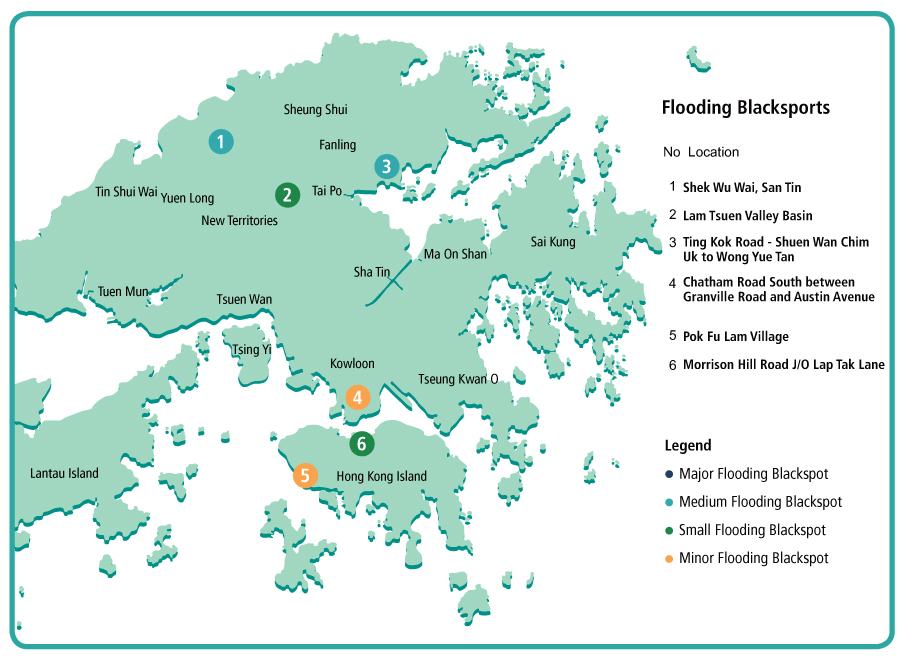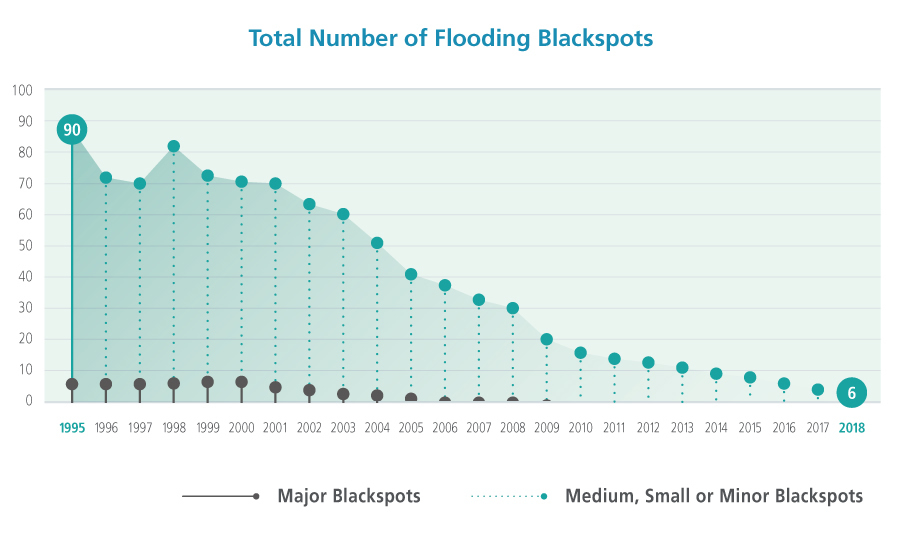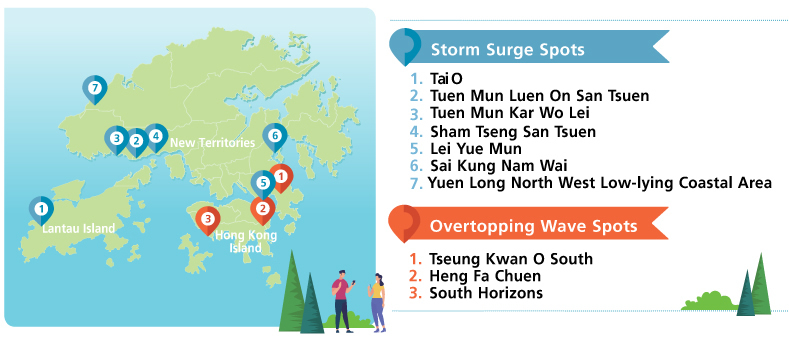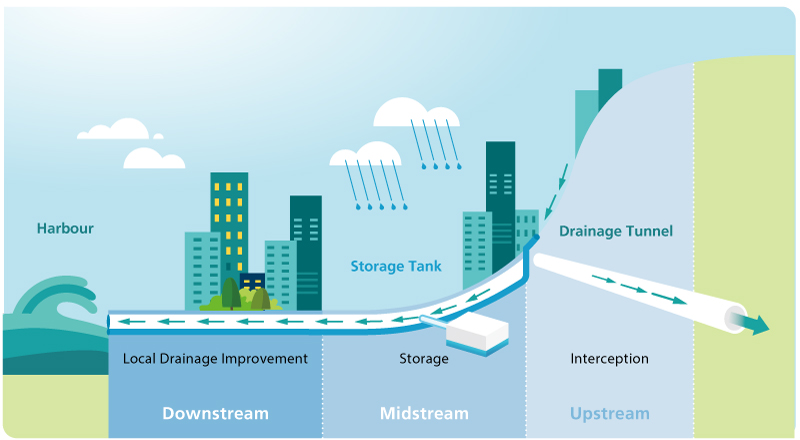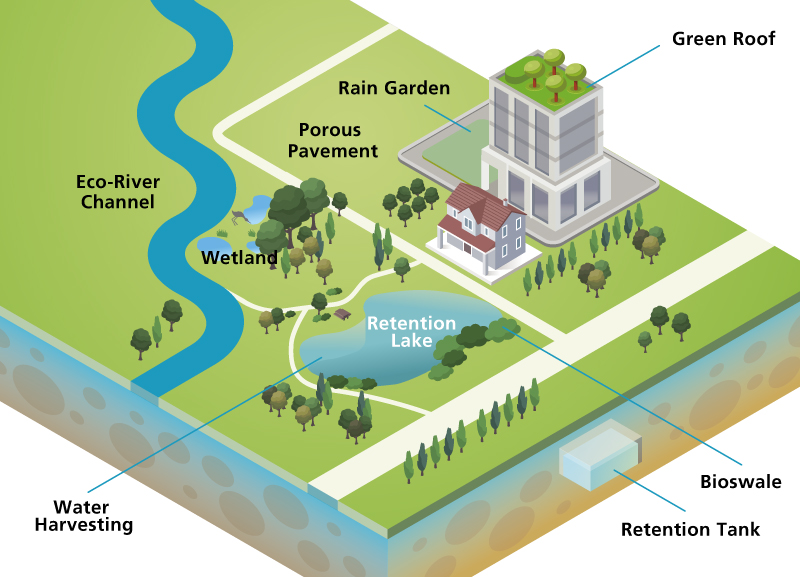Overview of Flood Prevention in 2018-19
In view of flood prevention, DSD makes reference to international standards for the design and construction of drainage facilities, and carries out regular inspections and maintenance works to ensure proper operation of our facilities. In 2018-19, DSD continued to implement various flood prevention projects. In addition, we are reviewing the Drainage Master Plans (DMPs) of various districts in stages, as to upgrade their flood protection level and tie in with Hong Kong’s future development.
There were drastic climate changes in 2018, with frequent typhoons and rainstorms. The storm surge caused by Super Typhoon Mangkhut, which hit Hong Kong in September, led to severe flooding in many coastal areas of the city and posed new challenges to our flood prevention works.
The annual total rainfall in 2018 was about 2,163 millimetres, slightly lower than the mean annual total rainfall of about 2,400 millimetres by approximately 10% between 1981 and 2010. In 2018, the Hong Kong Observatory (HKO) issued four Red and 19 Amber Rainstorm Warnings Signals. During the year, six tropical cyclones necessitated the issuance of tropical cyclone warning signals, similar to the long-term average in a year. HKO issued tropical cyclone warning signal No. 10 during the passage of Mangkhut in September, while issued five tropical cyclone warning signals No. 3.
Installation of flap valves at drainage outlets to prevent backflow of seawater
Flood walls at Kar Wo Lei, Tuen Mun
Demountable flood barriers at Tai O
The severe storm surge brought by Mangkhut raised the water level generally by more than two metres, resulting in unusually high water levels in many places in Hong Kong. On the afternoon of 16 September 2018, the water level at Quarry Bay rose to a maximum of 3.88 metres above Chart Datum (mCD), the second highest since instrumental water level measurement started in 1954, and only lower than the record high of 3.96 mCD set by Super Typhoon Wanda in 1962.
To minimise the flooding risk arising from Super Typhoon Mangkhut, DSD stepped up inspections and clearance of major drainage channels and inlets, particularly at flooding blackspots, to ensure the drains were free from obstructions. DSD had identified several low-lying coastal areas that are susceptible to tidal back flow, such as Tai O, Lei Yue Mun and Nam Wai in Sai Kung. DSD worked with other government departments and installed flood prevention facilities, such as installation of flood barriers and non-return flap valves, and construction of flood walls, etc. The Government had also established an early alert system for the above locations. When storm surge alerts were issued by HKO, DSD immediately implemented emergency flood relief measures at relevant locations with an aim to alleviate the flooding impact. Taking an example in Tai O, before the arrival of the typhoon, DSD deployed over 10 staff in Tai O for the installation of demountable flood barriers overnight in order to enhance the flood protection capacity of the river wall and to handle the emergency situation.
During the severe weather and before the Tropical Cyclone Warning Signal No. 8 was in force, we activated the Emergency Control Centre. Contingency teams were also deployed by DSD to stand by at the locations prone to flooding, to ensure that inspections and drain clearance would be conducted in time to reduce flooding risk. Around 120 staff in 30 teams were mobilised.
Close Monitoring of Flooding Blackspots
Last year, we implemented various drainage improvement works, evaluation was done on the effectiveness of each completed drainage improvement works at the beginning of 2019. At present, Hong Kong still has six flooding blackspots have not been removed, two of the remaining six flooding blackspots have had drainage improvement works commissioned and the effectiveness is being monitored. In order to remove all the flooding blackspots as early as possible, the first stage improvement works for the other four blackspots was completed while the next stage improvement works are under planning and design. We will closely monitor the drainage condition in these areas during the rainy season.
Location of Flooding Blackspots
Storm Surge Spots and Overtopping Wave Spots
Based on records, DSD has identified seven Storm Surge Spots, which are vulnerable to seawater inundation due to rise of sea level caused by storm surge during typhoon and three Overtopping Wave Spots, which are vulnerable to flooding due to wave overtopping the seawall. DSD has formulated measures to combat the problems with other departments.
Location of Storm Surge Spots and Overtopping Wave Spots
Overall Flood Prevention Strategy of Hong Kong
Compounded by urbanisation, increases in surface runoff and reduction of flood plains leads to flooding problems in the low-lying areas and coastal areas. To address the flooding problem in various places, we have developed a “three-pronged flood prevention strategy”, i.e. stormwater interception, flood storage and drainage improvement, which has proven to be effective in mitigating the flood risk arising from heavy rains.
-
Stormwater Interception: Building drainage tunnels to intercept stormwater from the mid-levels and discharge it directly into the sea or to other channels and drains
-
Flood Storage: Building storage tanks in the midstream for temporary stormwater storage to relieve the discharge load of the downstream drainage system
-
Drainage Improvement: Carrying out river training works or build new drainage channels and drains to upgrade the capacity of drainage system
Three-pronged Flood Prevention Strategy
Sponge City
To support the sustainable development of Hong Kong and respond to rising challenges of climate change, we introduced the “Sponge City” concept of “following the nature with resilience” to facilitate stormwater infiltration and reduce surface runoff through flood storage and retention. Part of the stormwater is collected and reused in an attempt to optimise water recycling across the city and enhance the flood resilience level of the city.
Operation and Maintenance of Existing Drainage Facilities
A clear and well maintained drainage system is a prerequisite to flood prevention. There are about 2,400 kilometres of underground stormwater drains, 360 kilometres of engineered channels, 21 kilometres of drainage tunnels, and four underground stormwater storage tanks in Hong Kong, all managed by DSD. During the year, we inspected over 2,310 kilometres of drains and rivers, which is about 23 kilometres longer than the total length of drains and rivers planned for inspection in 2018-19. Apart from regular inspections and preventive maintenance works, we also conduct regular functional and structural checks and clear blockages before and after the rainy season.
Emergency and Response
-
Emergency and Storm Damage Organisation (ESDO) operates round the clock to coordinate the dissemination of information relating to emergencies and allocation of resources, as well as to liaise with other government emergency units
Interception
-
Stormwater is intercepted upstream and diverted for direct discharge to the sea or rivers, thereby substantially mitigating the flood risk in downstream areas
-
Obviate the need for large-scale drainage improvement works in downstream urban areas, thereby reducing the impacts on traffic and the public
-
Four drainage tunnels (including Kai Tak Transfer Scheme, and Hong Kong West, Lai Chi Kok and Tsuen Wan Drainage Tunnels) totaling about 21 kilometres in length have been in operation for many years
Flood Storage
-
During heavy rainstorms, some stormwater in urban areas is diverted to storage tanks for temporary storage to relieve the burden of downstream drainage systems
-
Four stormwater storage schemes at Tai Hang Tung, Sheung Wan, Happy Valley and On Sau Road are now in operation
-
To further alleviate the flood risk in Kowloon, various stormwater storage schemes have been formulated and planned for further investigation
Drainage Improvement
-
Drainage improvement works are carried out to straighten, widen and deepen rivers and to construct or enlarge underground drains
-
Over 100 kilometres of rivers have been improved and about 94 kilometres of drains upgraded to date
Village Flood Protection Schemes
-
Construct embankments around low-lying village and build flood storage ponds and stormwater pumping stations in villages for temporary storage of stormwater during heavy rainstorms and subsequent discharge by pumping
-
27 Village Flood Pumping Schemes are currently in operation, providing flood protection for 35 low-lying villages




